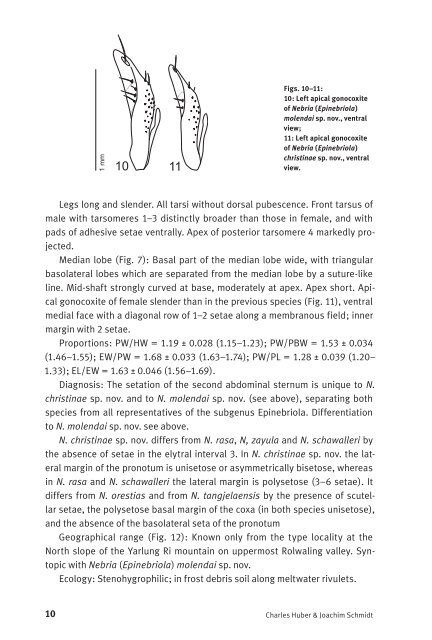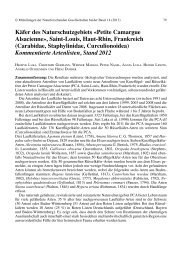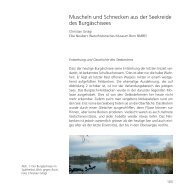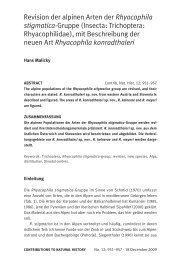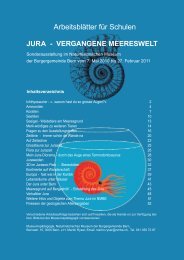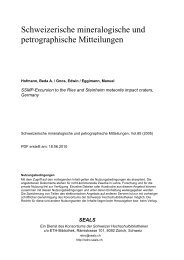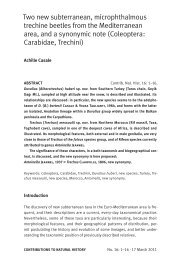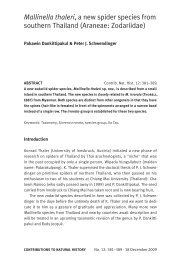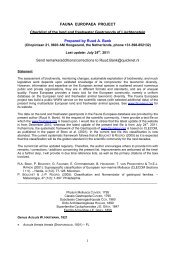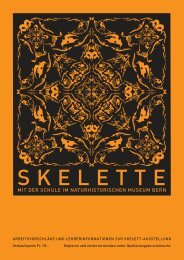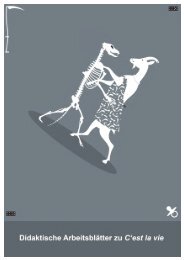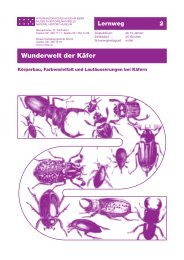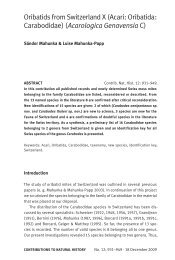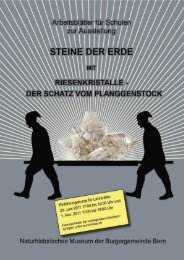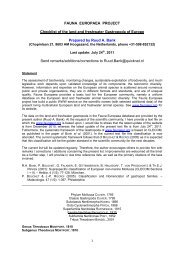Nebria - Naturhistorisches Museum Bern
Nebria - Naturhistorisches Museum Bern
Nebria - Naturhistorisches Museum Bern
Sie wollen auch ein ePaper? Erhöhen Sie die Reichweite Ihrer Titel.
YUMPU macht aus Druck-PDFs automatisch weboptimierte ePaper, die Google liebt.
Figs. 10–11:<br />
10: Left apical gonocoxite<br />
of <strong>Nebria</strong> (Epinebriola)<br />
molendai sp. nov., ventral<br />
view;<br />
11: Left apical gonocoxite<br />
of <strong>Nebria</strong> (Epinebriola)<br />
christinae sp. nov., ventral<br />
view.<br />
Legs long and slender. All tarsi without dorsal pubescence. Front tarsus of<br />
male with tarsomeres 1–3 distinctly broader than those in female, and with<br />
pads of adhesive setae ventrally. Apex of posterior tarsomere 4 markedly projected.<br />
Median lobe (Fig. 7): Basal part of the median lobe wide, with triangular<br />
basolateral lobes which are separated from the median lobe by a suture-like<br />
line. Mid-shaft strongly curved at base, moderately at apex. Apex short. Apical<br />
gonocoxite of female slender than in the previous species (Fig. 11), ventral<br />
medial face with a diagonal row of 1–2 setae along a membranous field; inner<br />
margin with 2 setae.<br />
Proportions: PW/HW = 1.19 ± 0.028 (1.15–1.23); PW/PBW = 1.53 ± 0.034<br />
(1.46–1.55); EW/PW = 1.68 ± 0.033 (1.63–1.74); PW/PL = 1.28 ± 0.039 (1.20–<br />
1.33); EL/EW = 1.63 ± 0.046 (1.56–1.69).<br />
Diagnosis: The setation of the second abdominal sternum is unique to N.<br />
christinae sp. nov. and to N. molendai sp. nov. (see above), separating both<br />
species from all representatives of the subgenus Epinebriola. Differentiation<br />
to N. molendai sp. nov. see above.<br />
N. christinae sp. nov. differs from N. rasa, N, zayula and N. schawalleri by<br />
the absence of setae in the elytral interval 3. In N. christinae sp. nov. the lateral<br />
margin of the pronotum is unisetose or asymmetrically bisetose, whereas<br />
in N. rasa and N. schawalleri the lateral margin is polysetose (3–6 setae). It<br />
differs from N. orestias and from N. tangjelaensis by the presence of scutellar<br />
setae, the polysetose basal margin of the coxa (in both species unisetose),<br />
and the absence of the basolateral seta of the pronotum<br />
Geographical range (Fig. 12): Known only from the type locality at the<br />
North slope of the Yarlung Ri mountain on uppermost Rolwaling valley. Syntopic<br />
with <strong>Nebria</strong> (Epinebriola) molendai sp. nov.<br />
Ecology: Stenohygrophilic; in frost debris soil along meltwater rivulets.<br />
10 Charles Huber & Joachim Schmidt


